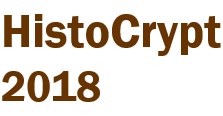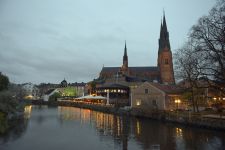

Home Important dates Organization Proceedings Program Invited speakers Accepted papers Workshops Instructions for presenters Instructions for authors Call for papers Venue and Social Events Accommodation Local information About Uppsala Travel to Uppsala Sponsorship Past events
International Conference on Historical Cryptology
Workshops
Registration to the main conference and the workshops will open in mid April on the conference website.
• Workshop 1: (Automated) Cryptanalysis of Classical Ciphers with CrypTool 2
• Workshop 2: Solving codes rather than ciphers. Is there a software challenge?
• Workshop 1: (Automated) Cryptanalysis of Classical Ciphers with CrypTool 2
CrypTool 2 (CT2) is an open-source e-learning tool consisting of several classical as well as of modern cryptographic algorithms (ciphers). The main goal of the CrypTool 2 team is to integrate every established cryptographic algorithm. Besides implementing the ciphers, the team also aims at integrating the state-of-the art of cryptanalytic algorithms, allowing to (automatically) break classical ciphers. CT2 implements a powerful graphical "programming language" allowing the user to combine arbitrary algorithms and analysis methods.
In this workshop, the participants will learn how to work with CT2. They will learn the basic handling of the graphical programming language. To allow non-cryptanalysts to participate at the workshop, a small introduction of classical ciphers as well as their cryptanalysis will be shown. The main goal of the workshop is that the participants are able to break classical ciphers on their own at the end of the workshop.
The workshop will consist of the following parts:
1. Basic classical encryption techniques
Topics here are:
• What is a cipher?
• Monoalphabetic and polyalphabetic substitution ciphers, single and columnar transposition ciphers, composed ciphers (e.g. ADFG(V)X), machine-based ciphers (Enigma), codebooks and nomenclatures, homophone ciphers
2. Basic handling of CT2
3. (Basic) Cryptanalysis of classical ciphers with CT2
• Transcription: From paper to machine-readable? Transcription in CT2
• What is cryptanalysis?
a) Identifying the ciphers (text statistics, Index of Coincidence)
b) Breaking monoalphabetic substitution ciphers
c) Breaking columnar transpositon ciphers
4. A view beyond - modern ciphers in CT2
5. Open Work and Todos in CT2 - what will the future bring? Our roadmap!
All participants will get a set of "tasks" which they will solve during the workshop.
Please bring your own PC with CrypTool 2 installed, see https://www.cryptool.org/modules/mod_ctdownloads/assets/curversion.php for download.
Instructions: https://www.cryptool.org/workshop.pdf
Tasks: https://www.cryptool.org/tasks.txt
Organizers: Nils Kopal, Armin Krauss and Bernhard Esslinger
• Workshop 2: Solving codes rather than ciphers. Is there a software challenge?
Problem: European archives and libraries contain a great many unsolved encrypted messages, mainly, from the Early Modern period, but not exclusively so. More often than not these messages were encoded, not enciphered: that is to say: encrypted word by word – and occasionally syllable by syllable – by means of nomenclatures, not letter by letter by means of a cipher. In the majority of cases, however, we see hybrid forms: a cipher used in combination with a nomenclature. During the 16th century this the rule, not the exeption. In fact, during the 17th and 18th century – at least in diplomacy – we can see nomenclatures growing in size, importance and complexity at the expense of ciphers who play only a secondary role.
During the 19th century nomenclatures assume a new role in telegraphic codebooks primarily issued for commercial use, aimed at cost-saving, not at secrecy. Usually these booklets, with each page containing a list of words, numbered in alphabetical order, would be printed without proper page numbering, could be purchased at any bookshop, and could be customized by filling on the page number in a random order, rendering a range of different 4-digit codegroups for each company. Shortly before the first world war we witness the emergence of military codebooks, increasingly used for radio traffic, secrecy often being served by means of superencipherment. Needless to say, these codebooks could greatly vary in organization, in size and in vocubulary. The diversity is immense, but would it make sense to look for a common denominator?
Purpose: This workshop aims at finding a common ground for the the solving of this kind of codematerial. Are we dealing with different challenges, depending on the type of codes used, or rather with one challenge, resulting in a one-size-fits-all toolkit, so to speak? Does the language matter? Would a historical language corpus do the the trick for establishing frequency counts, or should we rather focus on distilling frequency counts, based on related, unencrypted correspondence? Is the challenge more about statistics or more about information theory and computational linguistics? These are just some of the questions that can pass, but others can be about techniques already known from literature or the software already being available or in the process of making.
Form: a brainstorming-session, no longer than 4 hours, with 15 minute talks from all participants about their particular field of expertise, a round of questions about the talks and a second round for discussion, focused on particular topics.
Program:
- Anne-Simone Rous: The conversion of a database of early modern ciphers into an online portal
- Klaus Schmeh: Codes and Nomenclators: a systematic view
- Karl de Leeuw The codebook of Willem Six van Oterleek, Dutch Envoy in Russia from 1808 until 1810
- George Lasry: Insights from WWI codes
- Eugen Antal and Jakub Mírka: Selected encrypted messages found in Slovak and Czech archives
- (optional) Hans van der Meer: A known-plaintext attack on a coded letter by the Dutch Envoy in Sweden, Reinier van haeften, from 1776
Organizers: Karl de Leeuw (chair), Eugen Antal, Julio Hernandez-Castro, George Lasry, Hans van der Meer, and Klaus Schmeh.
Last update 2018-07-30